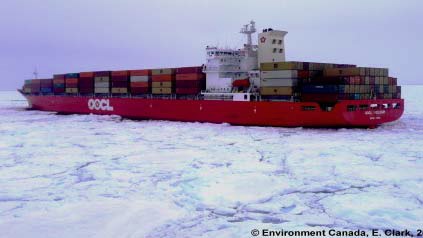
Ice Information Services of the World Work to Enhance the Safety of Marine Operations in Ice-Covered Waters
25th of October 2013 in Reykjavik, the capital city of Iceland hosted by the University of Iceland and the Icelandic Meteorological Office this month, experts from the International Ice Charting Working Group (IICWG) held their 14th annual meeting in Reykjavik, Iceland.
The IICWG issued the following statement: "While the extent of the Arctic ice pack rebounded somewhat this year from the record minimum set in 2012, this should not be taken as a sign that the trend of diminishing Arctic sea ice has stopped. This is an illustration of the extreme inter-annual variability that is to be expected. The long term trend remains toward a seasonally ice-free Arctic Ocean."
The retreat of the sea ice during the last two decades is facilitating a striking increase in marine activity in the Arctic which has prompted Arctic Council governments to adopt multinational agreements on Search-and-Rescue and Oil Pollution Response. At its meeting in Reykjavik, the members of the IICWG that provide information on sea ice and iceberg conditions discussed how they could best support Arctic and Antarctic Search-and-Rescue and Oil Pollution Response.
After setting a record minimum in 2012 of 3.4 million square kilometres, the sea ice pack in the Arctic Ocean recovered somewhat this year. The U.S. National Snow and Ice Data Center reports that the sea ice extent dropped to 5.1 million square kilometres on September 13, significantly more than the minimum in 2012 but still more than a million square kilometres less than the long term average.
- Active sea ice dynamics in the region forced the premature evacuation of the
Russian drifting ice station, North Pole-40.
- Passengers from a cruise ship were stranded for a short while on a drifting ice floe
that unexpectedly broke away from the shore in the Canadian Arctic
Less ice does not mean less danger – the large variability in local sea ice conditions from
year to year and from region to region presents major hazards for shipping and other
offshore activities.
- The tanker "Nordvik" entered Matisen Strait in Russia's Northern Sea Route
without permission due to its insufficient ice class and was holed by ice – there was no pollution.
- Some 35 adventurers attempting to cross the Northwest Passage in a variety of yachts and smaller boats were surprised by locally difficult ice conditions causing some to abandon their attempt.
- Supply barges carrying goods for some Arctic Canada communities were delayed by ice conditions more difficult than experienced in recent years.
- The ice extent in the Baltic Sea was average. The ice melt started late keeping icebreakers working late in the season.

Commercial interest in the Arctic is increasing rapidly.
- By October 23, thirty-one ships (all escorted) have made complete transits of the Northern Sea Route this year, including the first ever container ship. Six hundred and one authorizations were issued for voyages within the NSR, about half of which were escorted in convoy.
- The Nordic Orion, carrying coal from western Canada to Finland, became the first bulk carrier to traverse the Northwest Passage.
- Oil and gas development is occurring in virtually every region of the Arctic including Russia, Norway, Iceland, Greenland, Canada and Alaska.
Greenland glaciers continue to calve huge "ice islands" that float southward into the North Atlantic. Pieces of these ice islands have been observed as far south as Newfoundland posing a danger to shipping and offshore operations.
While Arctic sea ice extent is diminishing, the same is not true of the sea ice around Antarctica where maximum sea ice extents have been slowly increasing during the austral winter.
President Olafur Ragnar Grimsson of Iceland addressed the meeting emphasizing the urgency for the scientific community to engage in dialogue with political and business leaders in shaping the future of the Arctic. He stressed that the Arctic is now a global concern and the guidance of scientific knowledge is critical to avoid irreversible mistakes.
The IICWG notes with satisfaction that Arctic governments are responding to the reality of this increasing activity in their northern waters. Russia has opened the first of ten new Search-and-Rescue Centres along the Northern Sea Route. The member states of the Arctic Council adopted important new agreements on emergency response. The IICWG looks forward to next year's release of the International Maritime Organization's Mandatory Polar Code. In their role of providing ice information for the safety of maritime activities in ice - covered waters, the IICWG members are working hard to support these initiatives.
The IICWG was formed in 1999 to promote cooperation between the world's ice services on all matters concerning sea ice and icebergs and brings together the operational ice services of Canada, Denmark (Greenland), Finland, Germany, Iceland, Norway, Poland, the Russian Federation, Sweden and the United States, as well as the British Antarctic Survey and the International Ice Patrol.
For more information, please see regional contacts on the IICWG web site:
http://nsidc.org/noaa/iicwg
For up to date information on Sea Ice Services in the world see:
http://wdc.aari.ru/wmo/docs/WMO574.pdf
For more information on the IICWG, please contact:
Mr. John Falkingham
IICWG Secretariat